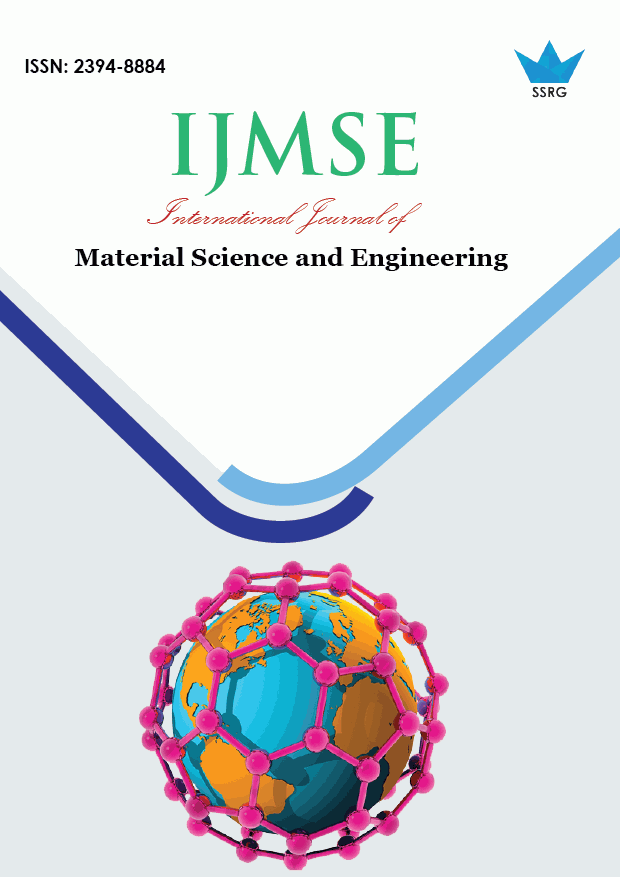Investigation of Electronic and Optical Properties of PbTe, PbSe, PbS Semiconductor Quantum Dots For Device Applications Using The Brus Equation

| International Journal of Material Science and Engineering |
| © 2025 by SSRG - IJMSE Journal |
| Volume 11 Issue 3 |
| Year of Publication : 2025 |
| Authors : G.C. Ogbu, O. K. Okongwu, U. D. Chukwuma, N . A. Akonjom |
How to Cite?
G.C. Ogbu, O. K. Okongwu, U. D. Chukwuma, N . A. Akonjom, "Investigation of Electronic and Optical Properties of PbTe, PbSe, PbS Semiconductor Quantum Dots For Device Applications Using The Brus Equation," SSRG International Journal of Material Science and Engineering, vol. 11, no. 3, pp. 1-4, 2025. Crossref, https://doi.org/10.14445/23948884/IJMSE-V11I3P101
Abstract:
Group IV–VI semiconductor Quantum Dots (QDs), particularly lead chalcogenides such as PbS, PbSe, and PbTe, have gained significant attention for next-generation optoelectronic and electronic devices due to their size-dependent band gap tunability and pronounced quantum confinement effects. In this study, the Brus equation is applied to theoretically examine how the energy band gap varies with quantum dot radius for PbS, PbSe, and PbTe. The analysis shows that as the dot radius decreases, the band gap increases owing to confinement of charge carriers, with the extent of tunability determined by each material’s intrinsic exciton Bohr radius and effective Mass. PbS QDs display the strongest quantum confinement, allowing band gap tuning from the Near-Infrared (NIR) to the visible range, making them ideal for solar cells, Light-Emitting Diodes (LEDs), and photodetectors. PbSe QDs, with moderate confinement, reach into the Mid-Infrared (MIR) region and are suitable for telecommunications, optical modulators, and infrared sensors. PbTe QDs exhibit weaker confinement due to their larger exciton Bohr radius, retaining narrow band gaps that are advantageous for thermoelectric devices, far-infrared detectors, and low temperature infrared lasers. These findings underscore the critical role of particle size in tailoring the optical and electronic properties of PbS, PbSe, and PbTe QDs, providing valuable guidance for their optimized deployment in photovoltaic, optoelectronic, and thermoelectric applications.
Keywords:
Band gap tunability, Exciton Bohr radius, Infrared sensors, Quantum confinement, Semiconductor quantum dots.
References:
[1] Louis Brus, “Electronic Wave Functions in Semiconductor Clusters: Experiment and Theory,” The Journal of Physical Chemistry, vol. 90, no. 12, pp. 2555-2560, 1986.
[CrossRef] [Google Scholar] [Publisher Link]
[2] Inuk Kang, and Frank W. Wise, “Electronic Structure and Optical Properties of PbS and PbSe Quantum Dots,” Journal of Optical Society of America B, vol. 14, no. 7, pp. 1632-1646, 1997.
[CrossRef] [Google Scholar] [Publisher Link]
[3] H.I. Ikeri et al., “Optical Properties of PbSe, PbS, and PbTe Semiconductor Quantum Dots and Their Applications,” International Journal of Materials Science and Engineering, vol. 10, no. 2, pp. 19–23, 2024.
[CrossRef] [Publisher Link]
[4] P. Dey et al., “Origin of the Temperature Dependence of the Band Gap of PbS and PbSe Quantum Dots,” Solid State Communications, vol. 165, pp. 49-54, 2013.
[CrossRef] [Google Scholar] [Publisher Link]
[5] Iwan Moreels et al., “Size-dependent Optical Properties of Colloidal PbS Quantum Dots,” ACS Nano, vol. 3, no. 10, pp. 3023-3030, 2009.
[CrossRef] [Google Scholar] [Publisher Link]
[6] Chenghui Xia et al., “Size-Dependent Band-Gap and Molar Absorption Coefficients of Colloidal CulnS2 Quantum Dots,” ACS Nano, vol. 12, no. 8, pp. 8350-8361, 2018.
[CrossRef] [Google Scholar] [Publisher Link]
[7] Arthur J. Nozik, “Spectroscopy and Hot Electron Relaxation Dynamics in Semiconductor Quantum Wells and Quantum Dots,” Annual Review of Physical Chemistry, vol. 52, pp. 193-231, 2001.
[CrossRef] [Google Scholar] [Publisher Link]
[8] A.J. Nozik, “Quantum Dot Solar Cells,” Physica E: Low-Dimensional Systems and Nanostructures, vol. 14, no. 1-2, pp. 115-120, 2002.
[CrossRef] [Google Scholar] [Publisher Link]
[9] A. Marti, and A. Luque, Next Generation Photovoltaics, High Efficiency Through Full Spectrum Utilization, Institute of Physics, Bristol, 2003.
[Google Scholar] [Publisher Link]
[10] Quantum Dots – Seeds of Nanoscience, The Royal Swedish Academy of Sciences, 2023.
[Publisher Link]
[11] Su-Huai Wei, and Alex Zunger, “Electronic and Structural Anomalies in Lead Chalcogenides,” Physical Review B, vol. 55, 1997.
[CrossRef] [Google Scholar] [Publisher Link]
[12] A. Franceschetti, A. Williamson, and A. Zunger, “Addition Spectra of Quantum Dots: The Role of Dielectric Mismatch,” The Journal of Physical Chemistry B, vol. 104, no. 15, pp. 3398-3401, 2000.
[CrossRef] [Google Scholar] [Publisher Link]
[13] Nisha Pandey, Amrita Dwivedi, and Arunendra Patel, “Theoretical Study of Dependence of Wavelength on Size of Quantum Dot,” International Journal of Scientific Research and Development, vol. 4, no. 1, 2016.
[Google Scholar]
[14] L.E. Brus, “Electron–electron and Electron–hole Interactions in Small Semiconductor Crystallites: The Size Dependence of the Lowest Excited Electronic State,” The Journal of Chemical Physics, vol. 80, no. 9, pp. 4403–4409, 1984.
[CrossRef] [Google Scholar] [Publisher Link]

 10.14445/23948884/IJMSE-V11I3P101
10.14445/23948884/IJMSE-V11I3P101